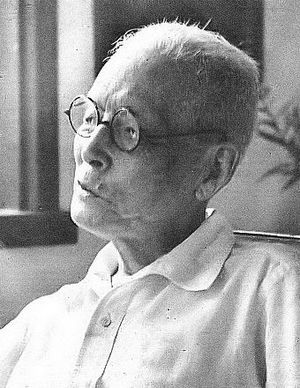Ichizō Kobayashi facts for kids
Quick facts for kids
Ichizō Kobayashi
|
|
|---|---|
| 小林 一三 | |
 |
|
| Born | January 3, 1873 Nirasaki, Yamanashi, Japan
|
| Died | January 25, 1957 (aged 84) Ikeda, Osaka, Japan
|
| Relatives |
|
Ichizō Kobayashi (小林 一三 (Kobayashi Ichizō, January 3, 1873 – January 25, 1957)) was a very important Japanese businessman. Sometimes people called him by his nickname, Itsuō. He is most famous for starting big companies like Hankyu Railway, the Takarazuka Revue (a famous all-female musical theater group), and Toho (a major film studio). He played a key role in Japan's economy and government during his time.
Contents
Early Life and Big Ideas
Ichizō Kobayashi was born in Nirasaki, Yamanashi, Japan, in 1873. He was named Ichizō, which means "one-three," because he was born on January 3rd. He finished his studies at Keio University in 1892.
After working at the Mitsui Bank for 14 years, he helped start the Mino-o Arima Electric Railway Company in 1907. This company later became Hankyu Railway.
Making Railways Popular
Kobayashi had a clever idea to make his railway company successful. He built train lines in areas that didn't have many people yet. To attract passengers, he built houses, an amusement park, and even a department store right next to his train stations. This made people want to live and shop along his railway lines.
He also created the Takarazuka Revue and a professional baseball team (which later became the Orix Buffaloes). These attractions brought even more people to use his trains. Other railway companies in Japan soon copied his successful business plan.
Later Roles
Later in his career, Kobayashi became a leader at the Tokyo Gas Electric Engineering Company. In 1940, he was put in charge of the Ministry of Commerce and Industry in the Japanese government.
After World War II ended, he served as a cabinet minister. He also became the head of the War Damage Rehabilitation Institute, which helped Japan rebuild after the war. However, he was temporarily removed from public life because of his earlier political roles. This ban was lifted in 1951.
Kobayashi passed away in January 1957. The Itsuō Art Museum in Ikeda, Osaka opened later that year. It displays his amazing art collection.
Diplomatic Mission in 1940
In September 1940, Ichizō Kobayashi led an important diplomatic trip for Japan. He was sent by the Ministry of Foreign Affairs to the Dutch East Indies (which is now Indonesia).
Oil Negotiations
The main goal of this trip was to make a new agreement about Dutch oil. Japan wanted to buy more oil from the Dutch East Indies.
On September 12, 1940, Kobayashi arrived in Batavia with a team of 24 Japanese officials. They wanted to talk about political and economic relations between Japan and the Dutch East Indies.
Japan asked for a big increase in oil exports, from 570,000 tons in 1939 to 3,750,000 tons. This would have been about half of all the oil produced in the Dutch East Indies. The Dutch explained that they could only increase exports to about 1,800,000 tons due to their existing agreements.
Kobayashi first accepted this offer, but he was called back to Japan on October 2, 1940. Another Japanese diplomat, Kenkichi Yoshizawa, then took over the negotiations.


